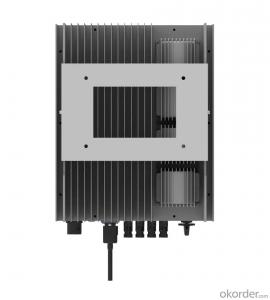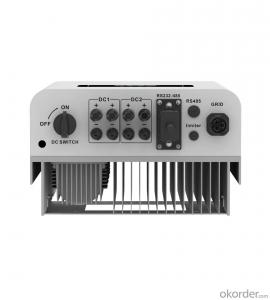SUN-7/7.5/8/9/10/10.5K-G | 7-10.5KW | Single Phase | 2 MPPT
- Loading Port:
- Ningbo
- Payment Terms:
- TT OR LC
- Min Order Qty:
- 100 pc
- Supply Capability:
- 5000 pc/month
OKorder Service Pledge
Quality Product, Order Online Tracking, Timely Delivery
OKorder Financial Service
Credit Rating, Credit Services, Credit Purchasing
You Might Also Like
Item specifice
Output Power:
7kw-10.5kw
Inveter Efficiency:
97.5%
Output Voltage(V):
220
Input Voltage(V):
550
Output Current(A):
30.4-45.7
Output Frequency:
50/60Hz
| Model | SUN-7K-G | SUN-7.5K-G | SUN-8K-G | SUN-9K-G | SUN-10K-G | SUN-10.5K-G | |
| Input Side | |||||||
| Max. DC Input Power (kW) | 9.1 | 9.8 | 10.4 | 11.7 | 13 | 13.7 | |
| Max. DC Input Voltage (V) | 550 | ||||||
| Start-up DC Input Voltage (V) | 80 | ||||||
| MPPT Operating Range (V) | 70~500 | ||||||
| Max. DC Input Current (A) | 13+26 | 26+26 | |||||
| Max. Short Circuit Current (A) | 19.5+39 | 39+39 | |||||
| Number of MPPT / Strings per MPPT | 2/1+2 | 2/2 | |||||
| Output Side | |||||||
| Rated Output Power (kW) | 7 | 7.5 | 8 | 9 | 10 | 10.5 | |
| Max. Active Power (kW) | 7.7 | 8.25 | 8.8 | 9.9 | 11 | 11.55 | |
| Nominal Output Voltage / Range (V) | L/N/PE 220V/0.85Un-1.1Un, 230V/0.85Un-1.1Un (Optional) | ||||||
| Rated Grid Frequency (Hz) | 50 / 60 (Optional) | ||||||
| Operating Phase | Single phase | ||||||
| Rated AC Grid Output Current (A) | 30.4 | 32.6 | 34.8 | 39.1 | 43.5 | 45.7 | |
| Max. AC Output Current (A) | 33.5 | 35.9 | 38.3 | 43 | 47.8 | 50.2 | |
| Output Power Factor | 0.8 leading to 0.8 lagging | ||||||
| Grid Current THD | <3% | ||||||
| DC Injection Current (mA) | <0.5% | ||||||
| Grid Frequency Range | 47~52 or 57~62 (Optional) | ||||||
| Efficiency | |||||||
| Max. Efficiency | 97.7% | ||||||
| Euro Efficiency | 97.5% | ||||||
| MPPT Efficiency | >99% | ||||||
| Protection | |||||||
| DC Reverse-Polarity Protection | Yes | ||||||
| AC Short Circuit Protection | Yes | ||||||
| AC Output Overcurrent Protection | Yes | ||||||
| Output Overvoltage Protection | Yes | ||||||
| Insulation Resistance Protection | Yes | ||||||
| Ground Fault Monitoring | Yes | ||||||
| Anti-islanding Protection | Yes | ||||||
| Temperature Protection | Yes | ||||||
| Integrated DC Switch | Yes | ||||||
| Remote software upload | Yes | ||||||
| Remote change of operating parameters | Yes | ||||||
| Surge protection | DC Type II / AC Type II | ||||||
| General Data | |||||||
| Size (mm) | 330W×410H×198.5D | ||||||
| Weight (kg) | 15.7 | ||||||
| Topology | Transformerless | ||||||
| Internal Consumption | <1W (Night) | ||||||
| Running Temperature | -25~65℃, >45℃ derating | ||||||
| Ingress Protection | IP65 | ||||||
| Noise Emission (Typical) | <25 dB | ||||||
| Cooling Concept | Natural cooling | ||||||
| Max. Operating Altitude Without Derating | 2000m | ||||||
| Warranty | 5 years | ||||||
| Grid Connection Standard | CEI 0-21, VDE-AR-N 4105, NRS 097, IEC 62116, IEC 61727, G99, G98, VDE 0126-1-1, RD 1699, C10-11 | ||||||
| Operating Surroundings Humidity | 0-100% | ||||||
| Safety EMC / Standard | IEC/EN 61000-6-1/2/3/4, IEC/EN 62109-1, IEC/EN 62109-2 | ||||||
| Features | |||||||
| DC Connection | MC-4 mateable | ||||||
| AC Connection | IP65 rated plug | ||||||
| Display | LCD1602 | ||||||
| Interface | RS485/RS232/Wifi/LAN | ||||||
· 2 MPP trackers, Max. efficiency up to 97.7%
· Zero export application, VSG application
· String intelligent monitoring (optional)
· Wide output voltage range
· Anti-PID function (Optional)
The single-phase inverter is one of the best options for residential application thanks to its smaller size and local LCD display, buttons. Also, with built-in zero-export function (external CT is needed), it offers true ease and comfort for PV system operators and installers.
- Q:Can a solar inverter be used with different AC voltages?
- No, a solar inverter cannot be used with different AC voltages. It is designed to convert the DC power generated by solar panels into a specific AC voltage that is compatible with the electrical grid. Using it with a different AC voltage could lead to inefficient operation or even damage the inverter.
- Q:What is the role of a power limiter in a solar inverter?
- The role of a power limiter in a solar inverter is to regulate and limit the amount of power that is fed into the electrical grid. It helps ensure that the solar system does not exceed the maximum power capacity of the grid, preventing any potential damage or overloading. The power limiter also helps maintain a stable and balanced power output, optimizing the efficiency and performance of the solar inverter.
- Q:Can a solar inverter be used with a solar-powered air cooling system?
- Yes, a solar inverter can be used with a solar-powered air cooling system. The solar inverter is responsible for converting the direct current (DC) generated by the solar panels into alternating current (AC) that can be used to power the air cooling system. This allows the system to operate efficiently using solar energy.
- Q:Can a solar inverter be used in systems with different module capacities?
- Yes, a solar inverter can be used in systems with different module capacities. Solar inverters are designed to convert the DC power generated by solar modules into AC power for use in homes or businesses. They are typically flexible and compatible with a wide range of module capacities, allowing them to be used in systems with varying sizes and configurations. However, it is important to ensure that the inverter's capacity matches or exceeds the total capacity of the connected solar modules to ensure optimal performance and efficiency.
- Q:What is the maximum AC output power of a solar inverter?
- The maximum AC output power of a solar inverter can vary depending on the specific model and size. Generally, residential solar inverters have a maximum AC output power ranging from 1 kilowatt (kW) to 10 kW, while commercial and utility-scale inverters can have much higher maximum AC output power, reaching up to several megawatts (MW).
- Q:What is the importance of voltage and frequency control in a solar inverter?
- Voltage and frequency control are crucial in a solar inverter as they ensure the stability and reliability of the electrical system. Voltage control regulates the output voltage of the inverter, ensuring it is within safe limits and compatible with the grid or the connected appliances. This is important to protect the electrical devices from overvoltage or undervoltage conditions, which could potentially damage them. Frequency control, on the other hand, maintains the output frequency of the inverter in synchronization with the grid frequency. This synchronization is vital for the seamless integration of the solar power into the existing electrical grid. Inconsistent frequencies can lead to instability, power quality issues, and potential damage to equipment. Overall, voltage and frequency control in a solar inverter play a significant role in maintaining a reliable and efficient electrical system, safeguarding the connected appliances, and ensuring the proper integration of solar power into the grid.
- Q:What is the role of a power factor controller in a solar inverter?
- The role of a power factor controller in a solar inverter is to regulate and maintain the power factor of the inverter's output. It ensures that the inverter's output power is in phase with the grid voltage, maximizing the efficiency of power transfer and reducing reactive power losses. By improving the power factor, the power factor controller helps to ensure stable and reliable operation of the solar inverter while meeting grid requirements and minimizing energy wastage.
- Q:What is the role of a solar inverter in a solar panel system?
- The role of a solar inverter in a solar panel system is to convert the direct current (DC) electricity generated by the solar panels into alternating current (AC) electricity that can be used to power common household appliances and be fed into the electrical grid. The inverter also ensures that the solar panels operate at their maximum efficiency by tracking the maximum power point to optimize energy production.
- Q:How does a solar inverter handle voltage phase imbalance in the grid?
- A solar inverter handles voltage phase imbalance in the grid by monitoring the phase angles of the grid voltage and adjusting its output accordingly. It continuously measures the phase imbalance and corrects it by injecting reactive power into the grid. This helps to balance the voltage across the different phases and maintain stable grid conditions.
- Q:How do you choose the right input voltage range for a solar inverter?
- To choose the right input voltage range for a solar inverter, it is essential to consider the specifications and requirements of both the solar panels and the inverter. The input voltage range of the inverter should be compatible with the output voltage range of the solar panels. It is important to ensure that the inverter can handle the maximum voltage generated by the panels during peak sunlight conditions. Additionally, factors such as temperature variations and system losses should also be taken into account while selecting the appropriate input voltage range for a solar inverter.
1. Manufacturer Overview |
|
|---|---|
| Location | |
| Year Established | |
| Annual Output Value | |
| Main Markets | |
| Company Certifications | |
2. Manufacturer Certificates |
|
|---|---|
| a) Certification Name | |
| Range | |
| Reference | |
| Validity Period | |
3. Manufacturer Capability |
|
|---|---|
| a)Trade Capacity | |
| Nearest Port | |
| Export Percentage | |
| No.of Employees in Trade Department | |
| Language Spoken: | |
| b)Factory Information | |
| Factory Size: | |
| No. of Production Lines | |
| Contract Manufacturing | |
| Product Price Range | |
Send your message to us
SUN-7/7.5/8/9/10/10.5K-G | 7-10.5KW | Single Phase | 2 MPPT
- Loading Port:
- Ningbo
- Payment Terms:
- TT OR LC
- Min Order Qty:
- 100 pc
- Supply Capability:
- 5000 pc/month
OKorder Service Pledge
Quality Product, Order Online Tracking, Timely Delivery
OKorder Financial Service
Credit Rating, Credit Services, Credit Purchasing
Similar products
New products
Hot products
Related keywords
































